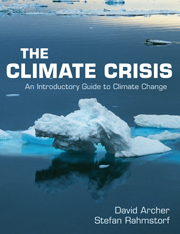Book contents
- Frontmatter
- Contents
- Preface
- 1 Retrospective: what we knew and when we knew it
- 2 Earth's energy budget
- 3 Climate change so far
- 4 Snow and ice
- 5 How the oceans are changing
- 6 The past is the key to the future
- 7 What the future holds
- 8 Impacts of climate change
- 9 Avoiding climate change
- 10 Climate policy
- Epilogue
- References
- Illustration credits
- Index
6 - The past is the key to the future
Published online by Cambridge University Press: 05 March 2013
- Frontmatter
- Contents
- Preface
- 1 Retrospective: what we knew and when we knew it
- 2 Earth's energy budget
- 3 Climate change so far
- 4 Snow and ice
- 5 How the oceans are changing
- 6 The past is the key to the future
- 7 What the future holds
- 8 Impacts of climate change
- 9 Avoiding climate change
- 10 Climate policy
- Epilogue
- References
- Illustration credits
- Index
Summary
Paleoclimatology, the study of past climates, is an expanding pursuit for the IPCC. There was some treatment of past climates even in the very first IPCC report published in 1990, but the coverage in the Fourth Assessment Report is in much greater depth and detail. Past climate changes can tell us something about the sensitivity of climate to atmospheric CO2 concentration and other changes in radiative forcing, independent of climate models. One important question that the study of past climate change might answer is, can past (natural) processes be affecting present-day climate evolution? Could the recent warming have natural causes?
As we gaze back into deepest time, we must rely on “proxy measurements” of past temperatures, ice sheet distributions, and atmospheric composition. For the most recent times, say the past thousand years or so, temperature records can be constructed using the widths of tree rings, and the temperatures inside ice sheets or the Earth (called borehole temperatures). Further back in time, measurements of the chemistry of calcium carbonate (CaCO3) sea shells, such as the proportions of the heavy and light isotopes of oxygen or the concentration of trace elements such as magnesium, can be used to infer changes in past climate.
Gas concentrations can be measured in bubbles trapped in polar ice cores dating back to 800,000 years ago so far. Beyond this, other clever methods have been derived to estimate CO2 concentrations in the deepest past, such as by analysis of CaCO3 deposits in ancient soils, or counting the vent cells, called stomata, on the under sides of leaves.
- Type
- Chapter
- Information
- The Climate CrisisAn Introductory Guide to Climate Change, pp. 105 - 124Publisher: Cambridge University PressPrint publication year: 2009



